|
On Saturday 6th July, we have a visit to Wild Woodbury, Bere Regis, with a walk of approximately 4km/2.5 miles across uneven ground around this rewilding community project guided by Dorset Wildlife Trust Ranger, Seb Haggett. There is a portaloo on site at the car park.
If you are used to walking poles it will be worth bringing them. Walking shoes/boots are advised and please bring a packed lunch and refreshments. The weather is looking good for Saturday, with dry, sunny spells forecast. There are ticks on site, along with longer vegetation, so trousers are recommended. Also bring along any wildlife spotting equipment, binoculars, cameras etc. Please let us know if you are planning to join the trip and where you will meet us. No dogs. Meet at the Nadder Centre car park at 9:30am or at 10:30am up a short track off Southbrook Road, opposite Eldon Road in Bere Regis. https://maps.app.goo.gl/qXbC482vgk4pZ6Qt6 What3words: permanent.kings.chef Those of you that came along to our meeting in January will recall the fascinating presentation by Rob Farrington of the work he has been leading for the past two and a half years to re-wild the 170-hectare site, south-east of Bere Regis. The plot acquired by Dorset Wildlife Trust was In September 2021 with plans to return what was previously intensively farmed arable land to its natural state. The goal was to create an example of sustainable land use, contribute to tackling the climate and ecological crises, reduce high nitrate levels in the area (and prevent them from entering Poole Harbour), and to engage the local community. In the first year of the project, the land was allowed to naturally regenerate: there was an immediate increase in biodiversity and abundance, with the site list reaching 1300 species. During 2023, the second year of the project, work was carried out to ‘re-naturalise’ the headwaters of the River Sherford that run through the site. More information: https://www.dorsetwildlifetrust.org.uk/blog/tag/wild-woodbury Anticipated end time: Returning to Tisbury by 3:30pm Shaun Leonard, Director of The Wild Trout Trust came to talk to us last month. The subject of rivers and water quality has risen towards the top of society’s interest recently and that was borne out in the good turn out for this excellent speaker.
Shaun started by outlining the organisation whose aim is ‘helping and inspiring everyone to protect wild Trout and their habitat.’ The Trust partners many other likeminded organisations to pack a bigger punch for conservation, with a nationwide team of conservation officers. He then outlined the various problems that rivers are facing ~ Quality: namely pollution from sewage spills and from farming especially. Quantity: water extraction, especially in the South East of England and abuse, such as canalisation, obstructions, straightening, and dredging where the river is separated from its flood plain. Shaun then went on to present some interesting, thought-provoking interesting facts on trout especially on trout parasites. For example, on dissecting one he found the entire digestive system filled with worms. Another had choked on another fish whilst trying to eat another trout nearly as big as itself! Apparently eating other Trout is normal behaviour and trout fry can form a major proportion of their diet. Shaun finished his talk by showing us some practical projects The Trust have been involved with, from Scotland to Somerset. Locally this is the construction of a bypass channel to Daslett hatches at Sutton Mandeville, working with Nick Lawrence and David Holroyd, and habitat improvement on the Nadder. Trout fishing has progressed from manicured banks and stocking with large Rainbow Trout towards a completely different way of thinking where improving habitat to aid the recovery of wild Brown Trout in a wilder more natural environment. The Trust works with volunteers in practical demonstrations and fun days out as well as helping in restoration projects to remove weirs and reducing bunds for example. Shaun took questions throughout his excellent presentation and again at the end, covering subjects of close interest to the audience, so we all came away wiser and more informed. Peter Shallcross 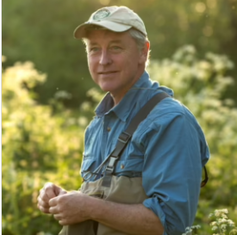 For the last in our winter series of indoor meetings, in the Victoria Hall, Tisbury High Street, at 7:30pm on Thursday 11 April, what more appropriate topic – after such a wet winter - than that of Wild Fish, and the work of the Wild Trout Trust? The Wild Trout Trust provides expert advice and practical project delivery across the UK and Ireland, as well as working to inspire others and give them advice and practical skills, to improve and maintain lakes and rivers for the benefit of trout and all wildlife. We shall hear from Shaun Lennard, an unashamed ‘fish bloke’ whose childhood was spent in and on the Indian Ocean and in the trout streams of southern Ireland. Shaun’s whole professional life, after degrees in marine biology and pollution, has been spent in fishery management; he was Head of Fishery Studies at Sparsholt College near Winchester until 2009. Since then, he has been Director of the Wild Trout Trust. The threat to wildlife from pollution of the River Nadder is not a new topic for the Society. We’ve heard previously from David Holroyd, one of our members, and last year we heard from the Director of the Wessex Rivers Trust. The issue matters particularly here in Wiltshire and Hampshire where most of the planet's chalk streams are located; the reason the River Nadder as a tributary of the Hampshire Avon is a 'Special Area for Conservation'. Shaun is the ideal person to tell us more on these things, about the continuing pressure on our rivers more widely, whether from sewage treatment, from farms or other sources, the potential role of the government’s recent initiative to create Local Nature Recovery Strategies and a host of other topics. As with all our events, this meeting is free if you’re a member of the Society or under 21, and you’ll be very welcome to come as a guest visitor for the payment of £2. Dick Budden Dave Rumble, CEO of Wessex Rivers Trust (WRT) spoke to one of our largest audiences in recent memory when 56 people came along to the first meeting of the new season to hear about water quality in the River Nadder, why it matters, and what can be done about it.
He explained that the Wessex Rivers Trust works with landowners and others to conserve rivers in a wide area covering the catchments of the Dorset Stour, the Hampshire Avon, the Test and the Itchen, as well as rivers in the New Forest, East Hampshire and the Isle of Wight. These include most of the chalk streams that are one of the UK’s most distinctive ecological habitats and make up 85% of all the chalk streams on the planet. Of these, The Avon, with its tributary the Nadder, is arguably the most important of them all. What makes chalk streams distinctive are that their source, the underlying chalk aquifer, favours a range of plants, such as the distinctive ranunculus (water crowfoot), the range of invertebrate species such as river flies that feed on these plants and the fish that live there. Dave described the way different invertebrates fulfil different roles, complimenting one another in living off the plant life and help keep the river clean, and made the point that their presence, or absence, are good indicators of a river’s health. And he drew particular attention to the presence in the Avon catchment – in addition to the grayling and trout that chalk streams are commonly known for – of a genetically distinct salmon sub-species that returns from the ocean to spawn here. It is this unique salmon and its vulnerability that makes conserving the Avon, and the Nadder, so particularly important from an ecological perspective. Together these are the reasons why the Nadder and the Avon catchment are considered a Special Area of Conservation. He described the ‘Trinity of Health’, or ‘three-legged stool’, that a healthy chalk stream and its ecology depend on, as Sufficient Flow or volume of water, Sufficiently Clean, and a Natural Habitat, and he went on to discuss the threats to each of these. The first point he made is that legacy issues take a long time to become apparent; because it may take years or decades for rainwater to percolate through the chalk aquifer, problems may only become apparent long after they were caused. He characterised the principle sources and causes of issues as; pressure from increasing population, climate change, agricultural practices, highways, the underinvestment in sewage treatment infrastructure, and septic tanks. Before talking about each of these and what can be done about them, he described the quality of water in the Nadder along its length. The Environment Agency analysis (using methodology that dates back to the relevant EU regulation) shows the Headwaters of the Nadder - above Wardour Lake - are Poor in quality. The Upper Nadder, from Wardour down to Tisbury, together with the River Sem, is Moderate, as is the stretch from Tisbury to Wilton. From Lower Wilton to Salisbury the river’s quality improves to Good. Dave explained that the presence of Phosphates probably arising from septic tanks and agricultural practices, are the most likely largest contributors to the Poor rating in the Headwaters and the Moderate rating in the Upper and Middle stretches. But in addition to the these there are signs of mercury and PBDE (a family of man-made flame retardant compounds used in a wide range of applications) that may come from highways or industrial sources and that are persistent pollutants. Quality improves further down the river, partly at least, as a result of settlement further upstream, and as the river flow increases. He drew attention to the fact that even treated effluent can cause serious pollution harm, in particular due to the emerging problem that pharmaceutical residues that are toxic to wildlife are not removed during treatment. In this context he also drew attention to the harm that can be caused to invertebrates by traces of insecticides used to treat dogs for fleas, and appealed to dog-owners to be alert to this and not let their pets swim in the river for several days following treatment. Turning to the issue of effluent treatment, Dave homed in on the issue of storm water overflows of raw sewage into the Nadder at Tisbury, Fovant and Barford St Martin, drawing attention to recently reported data showing that between them the three largest water companies, Thames, Southern and Wessex had spilled raw sewage during dry weather for 3,572 hours in 2022, a problem that will take huge investment to rectify. He went on to discuss the issue of broken or poorly functioning septic tanks, a problem that is largely hidden and that the government has attempted to address with new regulations introduced in 2020 requiring an upgrade, with installation of what is effectively a mini-effluent treatment plant, if you want to sell a house with a septic tank. And he explained the significance of the overturning a day previously in the House of Lords of Government plans to remove a requirement to safeguard river health by ensuring the nutrient neutrality of new developments. Dave gave examples of Wessex River Trust’s work to address some of the other problems he had mentioned, including changes to drainage to reduce the build-up of silt incorporating tyre residues and other pollutants resulting from run-off from roads. And he showed pictures of work to revive the river Test by reintroducing meanders, and the major project currently underway at Amesbury to revive the Avon’s ecology by reintroducing meanders that had been removed when the river was canalised to permit building of the roundabout at the junction of the A303 with the A345. And, in comments on the need to reduce fresh water consumption so as to preserve the flow of these valuable natural river systems, Dave emphasised the Trust’s work in education and engagement, involving children in exploring the diverse natural world of chalk streams and explaining to them how important this is. In a closing summary he stressed that a healthy chalk stream is self-cleaning and suggested anyone interested in pursuing the topic further should read a ‘Guide To River Restoration Techniques’ (on the Wessex Rivers Trust website) and ‘Rivers’ a book describing the natural and man-made changes that have affected British rivers since the last ice written by two river ecologists, Nigel Holmes and Paul Raven. In response to a question from the audience, Dave remarked that usually the best way to manage a risk of flooding was not to carry out dredging, but to increase the river’s capacity by restoring natural meanders and the flood plain, so as to hold back the flow, and mentioned that DEFRA are about to launch a £35million scheme to support flood management schemes. In response to a question about the impact of watercress, Dave said that, as with other forms of horticulture and agriculture, watercress growers using excess fertilizer could lead to nitrogen and phosphate run-off that would pollute the river. And in response to a question regarding water meadows, like the ones at Harnham above Salisbury Cathedral, he said these are amongst the most abundant wildlife habitats, although entirely artificial, having been created by farmers in the Middle Ages to provide early grazing for sheep. Dick Budden 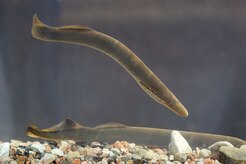 Lampreys Tiit Hunt, CC BY-SA 3.0 httpscreativecommons.orglicensesby-sa3.0, via Wikimedia Commons Lampreys Tiit Hunt, CC BY-SA 3.0 httpscreativecommons.orglicensesby-sa3.0, via Wikimedia Commons Well, some of us were brought up on King Henry 1 having died of a 'surfeit of lampreys', but I doubt anyone thought they (if they had any idea what 'they' were) could be found in our very own Nadder. However, it was Henry who probably 'defined' Clarendon Park, just the other side of Salisbury, and built the Hunting Lodge there - apparently out of Tisbury stone. So maybe it was Nadder lampreys he died of! This was a great opportunity to see the myriad forms of life that exist in our local river - including, as it turned out, lampreys - under the expert leadership of David Holroyd who is Membership Secretary Teffont Fishing Club and River Monitoring Coordinator for Salisbury and District Angling Club. As with our Harvest Mice Nest survey, there was a serious side to this. David explains that river quality and wildlife is deteriorating at an accelerating rate. This is particularly so in Wiltshire and Hampshire where 95% of the planet’s ‘Chalk stream habitat’ is located - strictly speaking the Nadder isn't itself a chalk stream although very similar. Because of the threat of continued deterioration and its unique nature and biodiversity, the whole of the River Avon and its four tributaries are designated a SSSI and subject to the status of being a ‘Special Area for Conservation’. David led members including Izzy Fry and other members of our Young Nature Watch group, to a favourite stretch of river, just outside Teffont Evias, where he collected samples from the river and brought them it to the bank for examination close-up in a sampling tray. As well as the lampreys and a number of insects, there were also brown trout, grayling, chub, dace and minnow. David says that the Nadder is currently in good health and being monitored throughout its length. This is especially important as the Nadder is also a key spawning habitat for the Avon Salmon, which is particularly endangered - and indeed, excitingly, salmon parr were also found. David's full account and list of sightings is here and there's an excellent account of the life-cycle of salmon here.
Andrew Graham said how fascinating – and surprising – it was to discover the wide variety of insects that give life to our rivers. He added, 'I have never seen a lamprey before and it opened my eyes to how much is going on in the Nadder, which to my ill-informed eyes, has always looked a bit uninteresting going through the village...' Certainly, to judge by these photos, a great time seems to have been had, as they say, by all. Great weather, too. |
Photo: Avocets (Izzy Fry)
The headers display photos taken by our members. Do get in touch via the Contact Form if you'd like to submit a photo for selection.
Archives
May 2024
Categories
All
|
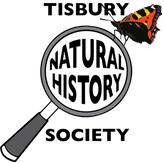
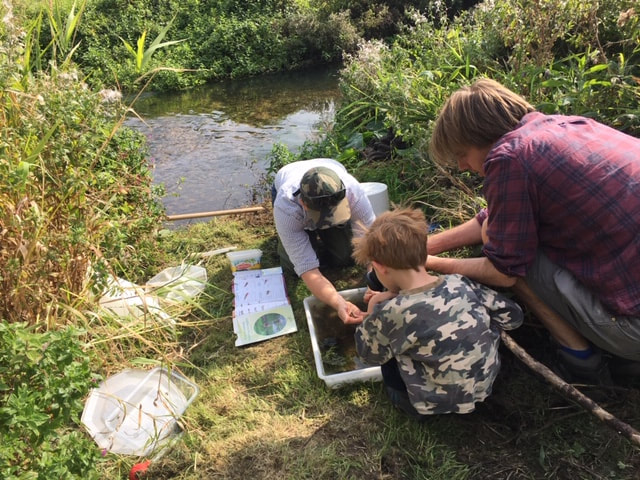
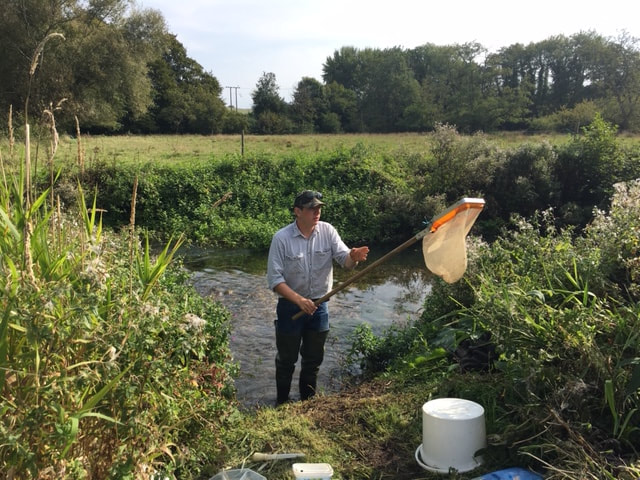
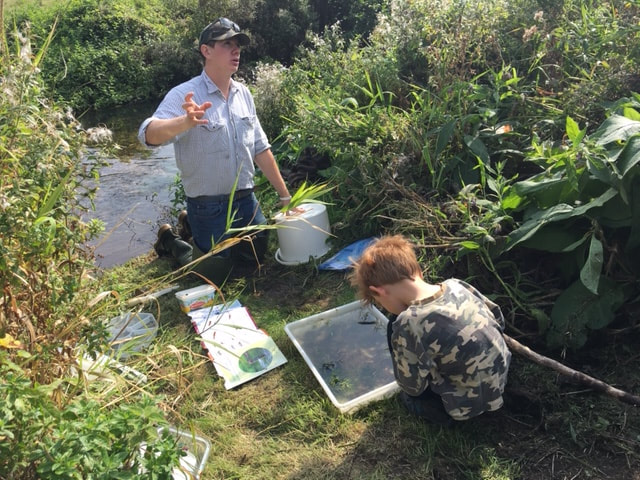
 RSS Feed
RSS Feed